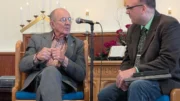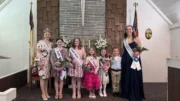Have you ever wanted to check out the glories of the Milky Way and the Big Dipper through a telescope? How about through a 30-inch Dobsonian telescope that is bigger than you are?
With the opening of a new observatory and learning center in Cranberry, the community will be able to do just that.
After delays due to COVID-19, the Oil Region Astronomy Learning Center is holding a grand opening at 5 p.m. Saturday.
The event will include tours, free food, a ribbon cutting, a presentation on “Searching for Planet Nine,” and a time for attendees to bring their own telescope for setup and instruction.
There will also be night-sky observation using the three telescopes at the center.
The presentation will be by Arthur Kosowsky, who is a professor of physics and astronomy at the University of Pittsburgh and associate director of the Pittsburgh Particle Physics, Astrophysics and Cosmology Center (PITT PACC).
“This new facility houses the largest telescope available for public observing in western Pennsylvania and is an education and economic asset to the region,” said Tim Spuck, president of the Astronomical Society.
Construction of the learning center began in 2014 and was completed in 2019. Its opening had been planned for the spring of 2020, but then COVID hit.
A 25-acre plot of land was donated to the Astronomical Society by Rod Bedow for the project, and the observatory was named the Bruce M. Bedow Memorial Observatory in honor of his father.
The closure of the observatory involved a long legal process, but “It was something that ended up being a win-win for everyone,” said Spuck.
When the observatory closed, the Astronomical Society still had a vision “to get the public out, get them interested in astronomy and just looking up,” said Spuck.
“About 80% of people in the United States live in an area where they can’t go out and see the Milky Way. So we have something that is very rare here in the Venango, Clarion, Forest area where people can go out and see the night sky and be inspired by it,” Spuck said.
The Astronomical Society is a 501C3 non-profit organization and currently has about 60 members. About 15 of them are active in the organization, said Spuck.
Spuck, one of the few founding members of the Astronomical Society, shared that in 1990 while he was a teacher at Oil City School District, he met another teacher from a wealthier community that had an observatory for its students to use.
“At that point, I got this thought in my mind. You know what, the wealth of the area shouldn’t dictate the resources kids have to learn. Then it was about getting the community on board,” Spuck said.
Spuck and the Astronomical Society succeeded in doing just that. The non-profit raised $200,000 to build the new learning center, as well as donated time and materials.
“It wasn’t a small project, and it is something that took persistence and time and dedication from ORAS membership as well as the community itself… It is through just tremendous community support,” Spuck said. “We are indebted and very thankful to businesses and funding agencies within the community,” Spuck said.
More information can be found at www.oras.org.








































